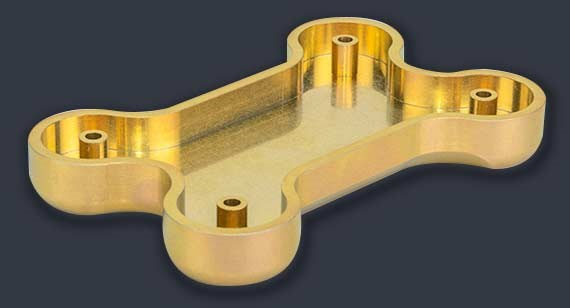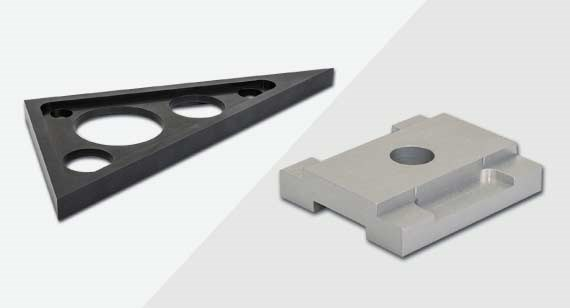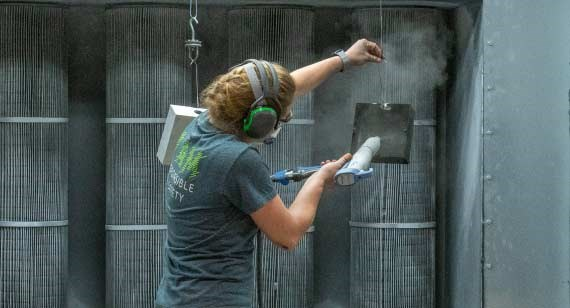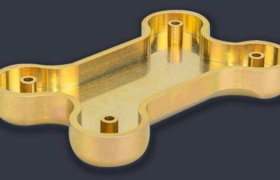Perhaps you’re wondering how to keep the 4140 steel brackets you’re ordering free of rust. Maybe you want your custom-made aluminum bicycle pedals to be a beautiful shade of blue, or the threaded fasteners you’re having turned more durable. These are but a few examples of how we can help you make sheet metal and CNC machined parts perform better, make them more wear- and corrosion-resistant, and improve parts’ overall appearance, by using various finishing options. These options, covered in this design tip, include: plating, anodizing, sealing, powder coating, painting, and passivation.

Plating is Suitable for a Range of Materials
For those of you needing a durable, corrosion- and wear-resistant finish, suitable for a wide variety of materials, look no further than nickel plating. Multiple types are available. At FacFox, we offer the two most common. The first of these—bright nickel plating—is applied by negatively charging a workpiece after submersion in a tank of electrolyte. Current is applied to a series of nickel anodes within the tank, slowly releasing nickel ions that migrate through the solution and bond themselves to the part.
As its name implies, bright nickel is shiny. Depending on the amount of current applied and time spent in the tank, thickness can range from 0.00005 in. to 0.001 in. (0.00127mm to 0.0254mm). Chances are good that your old car’s bumper is nickel-plated, as are the trim pieces on the dash, and the lighting fixtures in your house. All are covered under SAE AMS QQ N 290, although other standards apply. Electroless nickel plating eliminates the need for electrical contact and the subsequent electrical flow just described. For this reason, it’s a favorite for high-volume plating of fasteners, fittings, and other hardware items. It is also very useful for hard-to-reach interior areas as it plates evenly all over the part. It can be applied to almost any substrate: steel, stainless steel, aluminum, brass, and others. It also has excellent wear resistance compared to electroplated products. And, as with all of the other plating, coating, and painting processe listed in this design tip, electroless nickel is suitable for machined or fabricated components.
Zinc, Tin, Gold, Silver, and Other Plating Options
The electroplating process just described can be applied to other metals as well. Exchange the nickel anodes for ones made of zinc, for example, and you’re left with a plating that’s great at protecting iron and steel from corrosion. Zinc should not, however, be used where parts will see temperatures greater than 500 degrees F or in marine environments. See see zinc coating ASTM B633-15 for additional information.
Due to its low cost, tin plating is also quite common. It is a soft, ductile, silvery-white metal that is not only corrosion-resistant but quite agreeable to soldering, so it is often used in the electronics industry for computer chassis and other components. Hot-dip tin plating is also possible, which together with its electroplated alternative is described in MIL-T-10727 (MIL is a military specification coating).
Then there are gold and silver plating options. From an electronics industry perspective, both are similar to tin, albeit with higher conductivity, solderabililty, and corrosion resistance, with a higher price to match. And as evident from their use in the jewelry and dinnerware markets, they have an attractive appearance. These and other metals may require that a “nickel strike” is applied to the surface before plating to improve adhesion. Nickel plating provides excellent adhesion properties, so it is often used as an “undercoat” for other coatings.
Anodizing is a Common Finishing Option
Anodizing is one of the most commonly performed of all finishing options. Often referred to as a plating operation, it’s technically an electrochemical conversion process that creates a thin oxide film on a metal part’s surface.

For this discussion, we’ll focus on aluminum anodizing as covered under standard MIL-A-8625, although anodizing of titanium and other metals is also possible. More on titanium shortly.
Three types of aluminum anodizing are available. Chromic Acid anodize (Type I) provides a whisper-thin but still durable coating, typically between 0.00002 in. and 0.0001 in. (0.00127mm and 0.00254mm) thick. It is gray in appearance but can be dyed a dull, non-reflective black. It’s commonly used for welded parts and assemblies, and as a primer before painting. Like all anodized surfaces, it is non-conductive.
Harder yet is Type II Sulfuric Acid anodize, also known as decorative anodizing for its ability to absorb practically any color dye. That said, it offers an exceedingly durable finish up to 0.001 in. (0.0254mm) thick that is also quite attractive. Everything from carabiner hooks and flashlight handles to motorcycle parts and hydraulic valve bodies can be Type II anodized.
Beyond this is Type III Hard Anodize, or Hardcoat. Its color ranges from dark gray to bronze-like and is the thickest anodize available, adding as much as 0.003 in. (0.0762mm) to a part diameter and twice that to threads. Where the dimensional impact of most coatings and platings is fairly minimal, Hardcoat is just the opposite, and must be considered when designing close-tolerance parts.
As mentioned, the anodizing of titanium components is also a possibility. Refer to standard Aerospace Material Specifications (AMS), especially AMS 2487 and AMS 2488 for additional details. And, real-world examples of anodizing of titanium components? In the medical industry, titanium medical devices are commonly anodized for color-coding purposes. In aerospace applications, titanium parts are anodized for increased corrosion resistance.
To close out this section, just a reminder about the use of military (MIL) and aerospace (AMS) standards throughout this discussion on anodizing and plating. If available, it’s always best to reference these and other applicable specifications when ordering from us; otherwise, we might be left wondering what kind of anodizing, etc. you’re requesting.
The table below outlines the three types of aluminum anodizing that are available.
| ALUMINUM ANODIZING | THICKNESS |
|---|---|
| Chromic Acid (Type I) | Range between 0.00002 in. and 0.0001 in. (0.00127mm and 0.00254mm) |
| Sulfuric Acid (Type II) | Up to 0.001 in. (0.0254mm) |
| Hard Anodize (Type III) | Up to 0.003 in. (0.0762mm) |
Keep in Mind Sealing After Anodizing
With some exceptions, parts are usually sealed immediately after anodizing in a bath of nickel acetate or hot deionized water, closing off the material’s microscopic pores. This process also generates different performance characteristics such as improved bonding and lubricity, depending on the type of anodizing and sealing process used.
For mission-critical parts, be sure to discuss your application requirements with one of our application engineers before proceeding.

Powder Coating or Painting for Machining, Sheet Metal Fabrication
Powder coating for sheet metal parts is another popular option. A staple of sheet metal fabricators like FacFox, think of it as dry paint that can be applied to any electrically-conductive metal.
This option works by spraying a polymer-based colored powder through a special gun that charges the individual paint particles as they pass, making them stick to the surface. The powder-coated part is then placed into a hot oven to cure.
Powder coating is thicker than traditional wet paint and is more durable and fade-resistant as well. It’s also better for the environment—any leftover powder can be reclaimed and reused, and there are no smelly VOCs (volatile organic compounds) to contend with like there is with paint. For parts that can’t resist the heat of the curing process, however, or ones that require a thinner coating than powder coat provides, paint is an excellent alternative.
In either case, we offer dozens of color choices and sheens. Paint and powder coat alike can be made glossy, flat, matte, or anything in between. Just let us know what you’re looking for using a Sherwin Williams paint code or equivalent, as this provides us with all the information needed to get the job done right. Color matching is generally not available, though for paint we may be able to color match.
Passivation Also Protects Parts
Finally, no discussion of plating processes would be complete without some explanation of passivating, a process that “converts” the outer surface of metals to an exceedingly thin layer of oxide. It is similar in this respect to anodizing, but it’s use is far more widespread, is applicable to a wide variety of metals, and is mostly performed without electricity.
Stainless steel is passivated to further reduce any chance of corrosion and remove any stray iron from machining operations.
Alloy steels, previously plated parts, and aluminum are subject to conversion coatings, like chem film, and use phosphate or chromate to create the protective outer surface. These conversion coatings create an additional protective film for plated parts and some alloys. Chromate and other chem-film coatings for aluminum have good corrosion resistance and are a great base for paint.
Ultimately, if you’d like to explore which type of plating or other finishing option is right for your parts and applications, just upload a CAD file to our website. In addition, as always, if you have any questions, feel free to contact an applications engineers at info@facfox.com.
